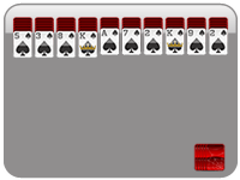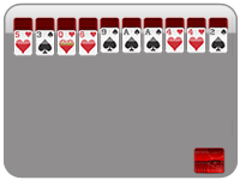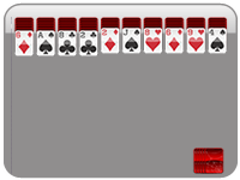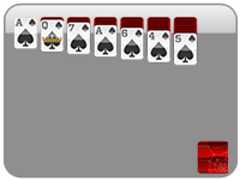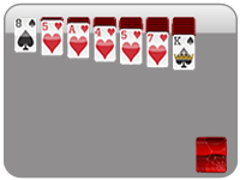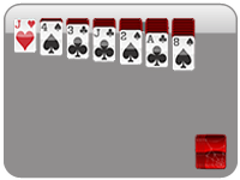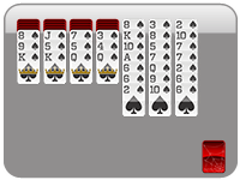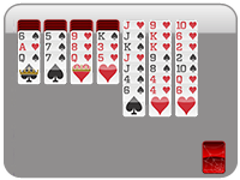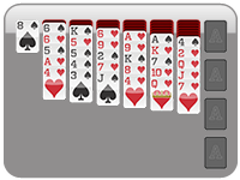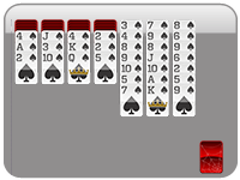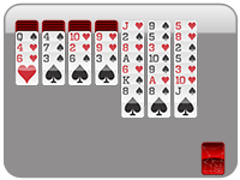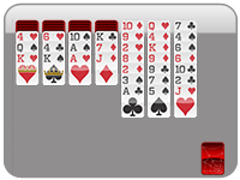Explore Different Types of Solitaire Games
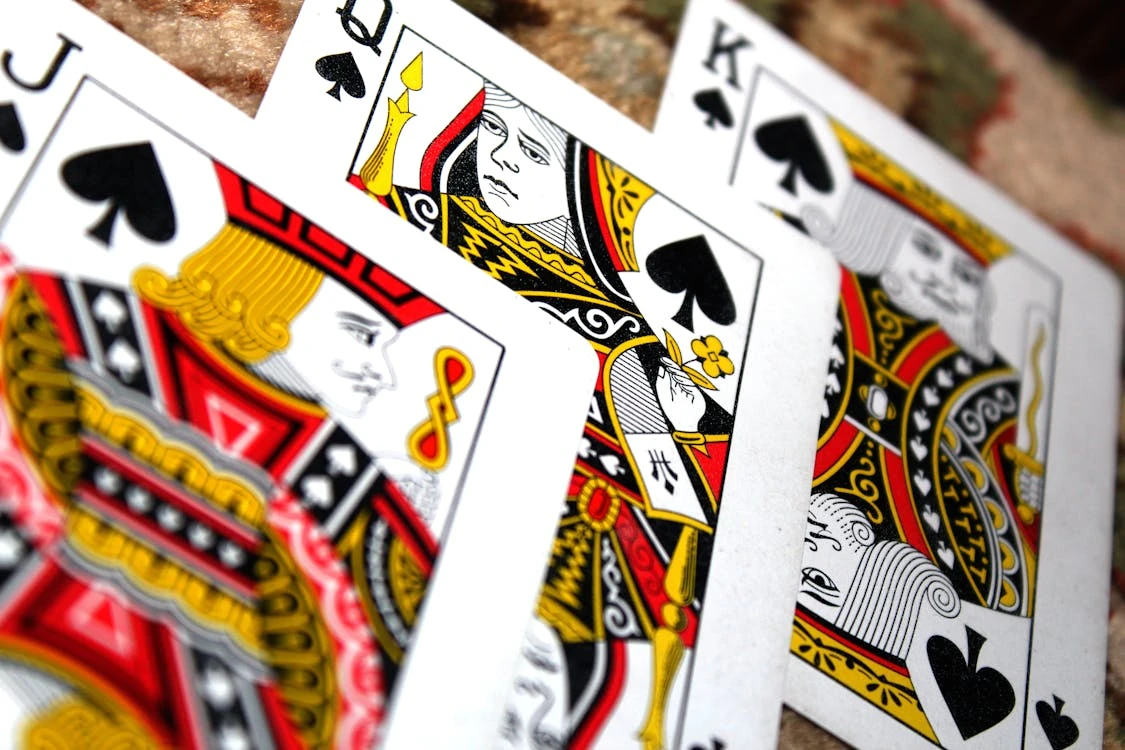
We’ve all played solitaire games at some point in our lives. They’re a great way to pass the time and you can spend hours moving cards around and trying to win. But did you know there are multiple varieties of this classic card game?
Solitaire is a term for a broader array of card games that hold similar features, primarily:
- The aim is to arrange the cards in a specific order
- You play them alone - which is where the word “solitaire” stems from
It could shock you to learn of over a dozen solitaire variants - so let’s look at four of the most popular and common games you’ll find these days.
Classic Spider Solitaire
Spider solitaire is traditionally a two-deck game involving all 104 cards. The goal is to create eight different sequences of cards across every suit in descending order from King to Ace. In other words, you have a suit starting with King of Diamonds and working down to Ace of Diamonds, then another in Clubs, Spades, and Hearts - plus four more because you’re using two decks so there are technically 8 full suits in total.
Each completed sequence gets removed from the playing area until you’re left with no cards, signaling a victory!
A classic game of spider solitaire is set up like this:
- All 104 cards are shuffled
- 10 piles are formed on the playing area
- The initial 4 piles (starting from the left) will have six cards while the other 6 have five
- The top card is turned over from each pile, leaving you with 10 visible cards to play with
- You can then move cards between piles, but can only move a card or sequence to another card of the same suit in descending order
- E.g. you can move a 4 of Spades below a 5 of Spades - and then this sequence of 5 & 4 under a 6 of Spades
- When a card is moved from a pile, turn over the next card underneath it
- If no more cards can be moved to different piles, deal an additional card across each pile so these cards now become the ones furthest down all 10 sequences
It’s believed the odds of winning spider solitaire are somewhere around the 1 in 3 region, though it depends on the type of spider solitaire you’re playing. Many solitaire fans also consider this one of the more challenging versions of the game as you’re using more cards and have to make more sequences.
Those of you who’ve never played this before should try 247 Spider Solitaire to get to grips with the game. It offers a great beginner level too, which includes all cards of the same suit so you’re just trying to make 8 sequences without worrying about suits. Then, graduate to adding in more suits for an even more challenging test!
If you’re wondering where the name “spider solitaire” comes from, it’s because you’re making 8 sequences. Each one represents the leg of a spider - a strange connection, but at least you can see where the name originates.
Unveiling Pyramid Solitaire
Are you looking for a massive solitaire test? Pyramid solitaire is one of the hardest variants of this fun card game and the odds suggest you’ll win 1 in every 50 games you play. It’s easy to see how this game got its name when you look at how the cards are dealt; you use a full deck of cards but deal 28 of them into a pyramid shape like this:
- 1 card at the top
- 2 below
- 3 below
- 4 below
- 5 below
- 6 below
- 7 at the bottom
The rest of the deck gets put to the side in a draw pile and you’re ready to start the game. Pyramid Solitaire has a simple goal: get rid of every card from the playing area. There’s just one tiny catch - you can only remove cards by pairing them to make 13.
E.g. A 5 and an 8 make 13, so you can take these two cards from the pyramid. Jacks count as 11, Queens 12, and Kings 13 - and you can remove a King on its own if you want.
The other thing that makes the game hard is that you can only remove cards that don’t have a card above them. In other words, you can only take pairs from the bottom row at the beginning of a game. If no pairs can be found, you may take a card from the draw pile and see if it matches with any. As you gradually remove cards from the bottom row of the pyramid it opens up cards from the next row to be taken, and so on.
You win the game when all cards are removed from the pyramid and you lose it if you go through the entire draw pile and haven’t removed every card. It’s one of the simplest solitaire concepts, yet has a low chance of winning.
Discovering FreeCell Solitaire
Your next variation is FreeCell Solitaire, which is a fairly common game and you’ve probably played it a few times before. It’s playable at 247 FreeCell if you want to practice and learn the ropes a bit - or you can play it with a standard 52 deck of cards.
FreeCell is set up as follows:
- All 52 cards are shuffled and then dealt face-up into 8 columns
- Four “free cells” and four “foundation piles” are present above the playing cards
- The foundation piles are where you build your sequence of cards from Aces to Kings all in the same suit
- Cards can be moved between columns in descending order through alternating columns
- E.g. You can move a red 8 below a black 9, and then move both below a red 10
- A card can also be moved to one of the four “free cells” to clear some space on the tableau if you’re struggling to move cards between columns
FreeCell is won when you manage all four piles of cards in ascending order from Ace to King. It’s quite tough to do this and there’s an element of luck involved in the initial draw. For instance, if you get a bad draw where all four Aces are way back in the columns, it can be hard to get to them and start your foundation piles. You need to pick your moves wisely as you can easily block yourself and end up with nowhere to go.
Exploring TriPeaks Solitaire
TriPeaks Solitaire is another 52-card game and it looks slightly similar to Pyramid Solitaire - only this time you have three pyramids forming three “peaks” like mountains. It’s quite a strange one to set up as the base of each pyramid overlaps, but here’s how you get the tableau in order:
- Start by creating three pyramids of 6 cards each
- Put one card at the top, two below, and three more below that - all of which are face down
- This will give you three pyramids with no spaces between the bottom row of cards
- From here, deal cards face-up to create an overlapping base across all three of the pyramids - each face-up card should be positioned over half of the card above
- This will mean every pyramid technically has a 4-card base, only they share one or two cards with the next pyramid in line
- E.g. The first pyramid on the left has four cards overlapping the three cards above it, meaning the fourth card along is placed half over the first pyramid and half over the second pyramid to begin its base
It might sound a bit confusing, but once you see the tableau in action, it all makes sense. The objective of TriPeaks Solitaire is also very similar to the Pyramid variation in that you’re trying to remove all cards from the three peaks.
The big difference is in how these cards get removed. You must select a card from the tableau and then pick one that’s either higher or lower than it to move to the discard pile. The goal is to try and create as long a sequence of cards as possible - suits don’t matter here, it’s all about the card’s rank/value.
As an example, imagine your tableau has the following cards along the bottom:
- 5, Ace, 3, Queen, 3, 2, 3, 8, 6, 8
Remember, they can be in any suit, but you could start removing some by clicking on the Ace then a 2, and then a 3. When a card above the bottom row is fully uncovered, it flips over. You can then use this card to help continue your sequence. In our scenario, if the card is either a 2 or 4, the sequence carries on.
One thing to note: your discard pile dictates what cards you can choose next. In our example, let’s say you get rid of the Ace, 2, and 3 but there isn’t another 2 or a 4 on the tableau. You might see a 7 and a 6 - which forms a sequence - but you can’t use them because your discard pile has a 3 as the top card.
When no more moves are available, you have to take a card from the draw pile. It now forms the start of a new sequence. You might flip it over and there’s a King - if you have a Queen, you can now remove it from the board and try to start a sequence in that order. It’s a relatively easy game to understand and most TriPeaks games are winnable. It becomes a case of how few moves you can make to win the game.
Benefits of Playing Solitaire
As you’ve seen, the solitaire choices are vast - and there’s a reason you can find so many versions of this game. It’s simply one of the most beneficial games to play and can help with the following:
- Decrease stress by challenging your mind and making you forget about your troubles
- Increase your problem-solving abilities
- Learn to develop more patience and how to adapt to setbacks
- Improve memory retention skills and keep your brain ticking over to help prevent or delay issues like Alzheimer’s
- Gives your concentration a boost as you’re forced to focus for long periods while playing
- Enhance your decision-making skills by learning how to pick the right moves every time
- Become a more strategic thinker as you must evaluate the tableau and think multiple moves ahead
Aside from all of these benefits, solitaire also helps you occupy free time when you’re bored. It’s a game you can play on your own whenever you like - and if you play traditionally with proper cards, then it offers a break from screen time too.
Choosing Your Ideal Solitaire Game
Other variations of solitaire exist, but we think the four in this guide are the best. Choosing your ideal one depends on what you’re looking for in a game of solitaire:
- If you want the easiest way to play without a huge challenge, opt for FreeCell
- If you want a slightly harder version of FreeCell with more cards, then go for Spider Solitaire
- If you want the biggest challenge of them all, pick Pyramid Solitaire
- If you like the format of Pyramid but want it to be easier, go for TriPeak Solitaire
We’d also say that FreeCell and Spider are more “traditional” versions of solitaire. They involve a classic card layout and are more about moving cards between piles and creating large sequences. If you want a different approach entirely, Pyramid and TriPeak offer something unique. In these games, it’s less about moving cards around and finding the right pairs. Pyramid is definitely a good one if you want a math challenge thrown in too.
Regardless, all forms of solitaire are beneficial and will provide endless fun. Our advice is to pick one and then move onto another when you start getting bored! Moving between versions keeps solitaire fresh and ensures you see enjoyment for a much longer time.
Spider Solitaire Games
More Solitaire Games
More Games
Spider Solitaire News
Disclaimer
DISCLAIMER: The games on this website are using PLAY (fake) money. No payouts will be awarded, there are no "winnings", as all games represented by 247 Games LLC are free to play. Play strictly for fun.

